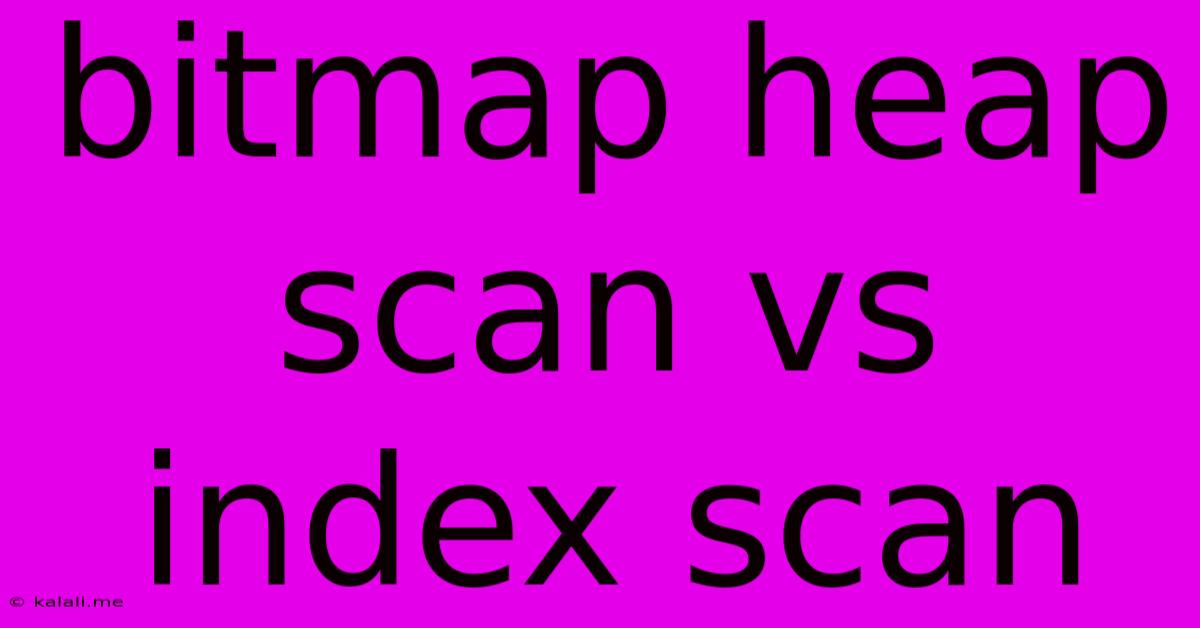Bitmap Heap Scan Vs Index Scan
Kalali
Jun 07, 2025 · 4 min read

Table of Contents
Bitmap Heap Scan vs. Index Scan: Choosing the Right PostgreSQL Execution Plan
PostgreSQL offers various execution plans to retrieve data efficiently. Two common strategies are bitmap heap scans and index scans. Understanding their strengths and weaknesses is crucial for optimizing query performance. This article will delve into the differences between these two methods, helping you choose the most efficient approach for your specific needs. Choosing the right execution plan can significantly impact query speed and overall database performance.
Meta Description: Learn the key differences between Bitmap Heap Scans and Index Scans in PostgreSQL, and how to choose the most efficient query execution plan for optimal database performance.
What is a Bitmap Heap Scan?
A bitmap heap scan is a specialized access method particularly efficient for queries involving multiple conditions on columns with low cardinality (meaning a small number of distinct values). Instead of directly accessing the heap, it works by creating bitmaps. Each bitmap represents a column value, and each bit within the bitmap corresponds to a row in the table. A '1' indicates that the row satisfies the condition, while a '0' indicates it doesn't.
For queries with multiple WHERE clauses, PostgreSQL combines these bitmaps using bitwise AND operations. This results in a final bitmap that identifies all rows matching all conditions. Finally, PostgreSQL uses this refined bitmap to directly access only the necessary rows in the heap.
Advantages of Bitmap Heap Scans:
- Efficiency with multiple conditions: Exceptionally fast for queries with multiple
WHEREclauses on low-cardinality columns. - Reduced I/O: Only the relevant rows are accessed, minimizing disk reads.
- Good for large tables: Can be highly effective even with very large tables.
Disadvantages of Bitmap Heap Scans:
- Inefficient for high-cardinality columns: The bitmaps become extremely large and slow to process.
- Not suitable for all queries: Not as versatile as index scans; not effective for range scans or queries involving complex expressions.
- Increased memory consumption: Creating and manipulating bitmaps can consume significant memory.
What is an Index Scan?
An index scan utilizes an index—a separate data structure that speeds up data retrieval—to locate rows that meet specified conditions. The database engine uses the index to quickly identify the row IDs (or pointers) that satisfy the WHERE clause without scanning the entire table. This significantly reduces the number of disk accesses required. Different index types, like B-tree indexes, GiST indexes, and GIN indexes, are optimized for different data types and query patterns.
Advantages of Index Scans:
- Fast for various query types: Efficient for range scans, equality comparisons, and other common queries.
- Versatile: Can be used with a wide range of data types and query conditions.
- Relatively low memory overhead: Compared to bitmap heap scans.
Disadvantages of Index Scans:
- Index maintenance overhead: Indexes need to be updated whenever data is inserted, updated, or deleted.
- Inefficient for queries with many conditions: The performance gain diminishes as the number of conditions in the
WHEREclause increases. - Less efficient for small tables: The overhead of using an index might outweigh the benefits for small tables.
Bitmap Heap Scan vs. Index Scan: Choosing the Right Plan
The choice between a bitmap heap scan and an index scan depends heavily on several factors:
- Cardinality of columns involved in the WHERE clause: Low cardinality favors bitmap heap scans.
- Number of conditions in the WHERE clause: Multiple conditions generally favor bitmap heap scans, while fewer conditions often favor index scans.
- Data type and query type: Index scans are generally more versatile and handle various query types effectively.
- Table size: For extremely large tables, bitmap heap scans can significantly outperform index scans for suitable queries.
- Index type and selectivity: The efficiency of an index scan is heavily dependent on the index type and how selective it is.
PostgreSQL's query planner automatically selects the execution plan it deems most efficient based on various factors, including statistics gathered on the table and indexes. You can however, examine the query plan using EXPLAIN or EXPLAIN ANALYZE to understand PostgreSQL's choice and identify potential optimization opportunities. Understanding the underlying mechanisms allows you to fine-tune your queries and database schema for optimal performance. Proper indexing and data modeling are crucial for leveraging the strengths of both bitmap heap scans and index scans.
Latest Posts
Latest Posts
-
How To Fix Ripped Drywall Paper
Jun 08, 2025
-
Find Position From Velocity Time Graph
Jun 08, 2025
-
Shes Like A Dog Bone To Me Meaning
Jun 08, 2025
-
Folder Of An Image Layer In Gimp
Jun 08, 2025
Related Post
Thank you for visiting our website which covers about Bitmap Heap Scan Vs Index Scan . We hope the information provided has been useful to you. Feel free to contact us if you have any questions or need further assistance. See you next time and don't miss to bookmark.